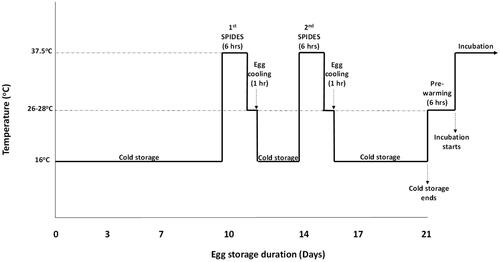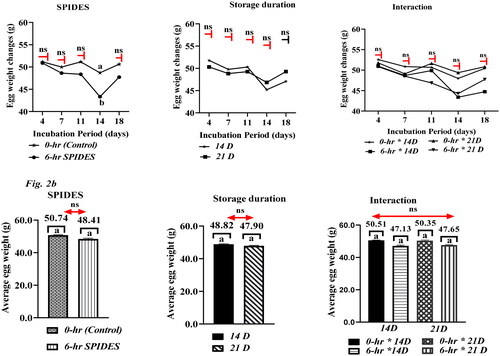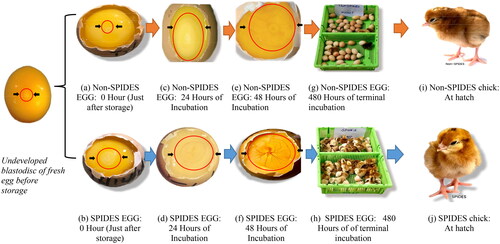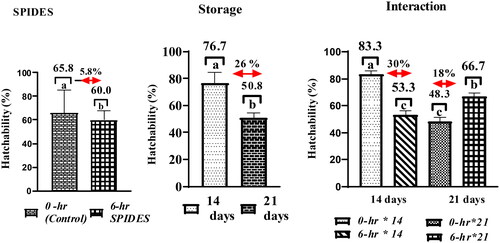Figures & data
Figure 1. A Graphical representation of the temperature-time chart of egg storage and SPIDES treatment before incubation.

Table 1. Effect of cold storage duration on basic egg quality parameters.
Table 2. Effect of short incubation period and different storage durations on egg weight loss of hybrid breeder ‘black-tailed’ eggs.
Figure 2. Representative profile of the impact of storage duration, SPIDES, and their interaction on egg weight (a) and average egg weight (b) during incubation. Data with bars having similar superscripts showed no significant difference (p > 0.05): ns: not significantly different; 0-h SPIDES – eggs that did not receive short period incubation during (control); 6-h SPIDES: eggs that received 6-h short period incubation during egg storage.

Figure 3. Comparative stages of embryonic development and chick quality at hatch for Non-SPIDES & SPIDES treated eggs after prolonged storage according to the procedures of Hamburger–Hamilton (1951) stages. KEY: Plates a, c, e, g, i (orange-arrows transition: Non-SPIDES or control treatments); Plates b, d, f, h, j (blue-arrows transition: SPIDES treatments); (a) Unincubated non–SPIDES egg. Blastoderm under-developed with unclear ‘donut appearance’. (b) Unincubated SPIDES egg. Blastoderm is well-developed with clear ‘donut-appearance’. (c) ‘donut-shape’ enlarged with no appearance of ‘blood islet’ (d) ‘donut-shape’ enlarged greatly with the appearance of ‘blood islets’ (e) ‘donut-shape’ enlarged greatly with only ‘blood islets’ in the outer ring of developing embryo. No appearance of the circulatory system and embryonic appendages at this stage (f) Clear appearance of an embryo with a well-developed circulatory system and embryonic appendage. (g) Protrated terminal hatching with few externally pipped chicks (h) rapid terminal hatching with more hatched and externally pipped chicks. (i) Poor quality chick (light, weak and passive) (j) good quality chick (heavy, thrifty, and active).

Table 3. Impact of storage duration, SPIDES, and their interaction on mean wet and dry embryo weight changes during incubation.
Table 4. Impact of storage duration, SPIDES, and their interaction on embryo length changes during incubation.
Figure 4. Representative profile of the impact of storage duration, SPIDES treatment, and their interaction on hatchability. Data bars with similar superscripts show no significant difference (p > 0.05): 0-h SPIDES: eggs that did not receive short period incubation during egg stage (control); 6-h SPIDES: eggs that received 6-h short period incubation during egg storage; interaction = SPIDES × storage duration interaction.

Table 5. Impact of storage duration, SPIDES, and their interaction on hatching traits.
Table 6. Impact of 6-h short period incubation during egg storage (SPIDES) on hematology of 7-day-old chicks.
Data availability statement
The data that support the findings of this study are available and will be provided at the request of the corresponding author.
